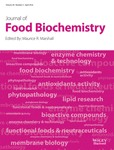Anti-Glycation of Active Compounds Purified from Graptopetalum Paraguayense
Abstract
Graptopetalum paraguayense was shown to exhibit antioxidant, hepatoprotective and anti-hepatocellular carcinoma activities in a recent study. In this work, fractions of the G. paraguayense aqueous solution were extracted using n-hexane, ethyl acetate (EF) and n-butanol, and its antioxidative and anti-glycative activities were evaluated. The EF extract exhibited the highest antioxidative activity, potently inhibited the formation of advanced glycation end products (AGEs) and reduced glycation-induced protein oxidation. Additionally, the EF extract protected Hep G2 cells against AGE-induced DNA damage. Five major components were isolated and identified in the EF fraction by semi-preparative high-performance liquid chromatography, liquid chromatography-tandem mass spectroscopy and nuclear magnetic resonance: gallic acid, isoquercitrin-6-(3-hydroxy-3-methylglutarate), astragalin-6-(3-hydroxy-3-methylglutarate), isoquercitrin-2-acetyl-6-(3-hydroxy-3-methylglutarate) and astragalin-2-acetyl-6-(3-hydroxy-3-methylglutarate). G. paraguayense exhibited antioxidant and anti-glycation activities, likely because of the presence of gallic acid. The findings indicate the potential for using G. paraguayense for development of novel treatments for diabetes.
Practical Applications
Herbal treatments for hyperlipidemia are relatively cheap and locally available. The results indicated that the extracts of Graptopetalum paraguayense may be developed as functional foods for antidiabetic treatment mediated by attenuations of advanced glycation end product oxidation.




